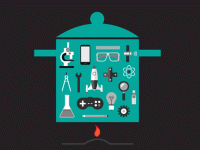STEM Is Jambalaya
Sitting in a restaurant on Frenchmen Street in New Orleans, my senses were gratified. I was taking in jazz and eating a meal after speaking at the National Science Teachers Association's (NSTA) STEM Forum. Midway through my feast, I glanced over to the menu, and was struck by an idea. STEM is jambalaya -- it is a melding of ingredients.
Now, for those of you who don't know what jambalaya is, imagine a combination of chicken, sausage, rice, shrimp, celery, and spices all mixed together. Separately, these items are just a grocery list, but combined they are a slice of heaven. And, while the ingredients are not inseparable, like a smoothie or tomato soup, each part builds on the next to create something new.
Jambalaya is a symbiosis, a synthesis, a fusion. The same goes for STEM.
What's in an Acronym?
Now, I'll be the first to admit how silly a comparison between food and an academic field sounds. But I have become more and more concerned with the STEM label, and how it is conditioning us to keep old habits. STEM is an unfortunate acronym, because we look for the S, the T, the E, and the M when we develop curriculum. That is, we look for where the science is, where the technology part goes, how engineering is present, and how can we add the math part. STEM is not S.T.E.M, where the letters are separated. STEM is a new word, a merger. We should have called STEM something completely different, just to force us away from this thinking of separate fields. STEM is a combination. It is all parts savored together, just like jambalaya.
And STEM brings us closer to the way society works. We created these separate fields because they are easier for us to understand the world when we put its parts into boxes. But nature doesn’t work that way. Take a tree, for instance. A scientist will categorize it as something to study through the lens of biology, botany, forestry, ecology, and many others. But Mother Nature just calls it "tree." It is all those things combined. That is the new mindset we need.
John Dewey wrote about simplification by isolation. It is something that we came up with to understand the world better. "We do not have a series of stratified earths, one of which is mathematical, another physical, another historical, and so on," said Dewey. He said this about education in general, but it applies to STEM, too. These separate fields make it easier for our human minds to understand things, but the world is a mixture of all these things at once, and should be presented and taught that way to children.
Blending the Ingredients
When I was speaking to teachers in New Orleans, one idea that I emphasized was how STEM is a meta-discipline. But after my talk, I realized that my words might have resonated more with this comparison to food. Think of it this way: when one eats jambalaya, does anyone separate the sausage from the rice or shrimp? Heck no! All the pieces are in there working beautifully together. That is where we need to get to when we're teaching STEM. We are always looking at curriculum and trying to map it to the old way of thinking about "where is the S or the T?" Good STEM has all of that working together seamlessly, just like a good meal.
Soon, we’ll have to lose the old way of thinking about STEM, because the future will demand it. Take, for example, the field of nanotechnology. Nanotechnology is the world of the small and strange. Small particles, which are 1/100,000 the thickness of your hair and act strangely, will be used to keep your pants from staining, make better sunscreens, make computers faster, and even cure cancer. So what discipline does nanotechnology fall under? The S, the T, the E, or the M? It falls under all of them! All those old disciplines, like biology, physics, electrical engineering, materials science, and chemistry, are coupled in a way that lets you move from one to the other without even knowing it. Nanotechnology is STEM jambalaya.
So we must be vigilant about not thinking of things in these separate fields, and start thinking of STEM as jambalaya, as a combination. Perhaps being near the French Quarter and listening to jazz and eating great food put me in a different mindset that let me see this. It seems that the arts (both culinary and musical) inspired my new thinking about STEM. And the A for the arts is the last missing piece to this jambalaya. There is still work needed to figure out how to do that best. The first step is to realize that STEM is jambalaya, and when we add the A to make it really STEAM, this blend of old-school subjects will be the best dish yet.
